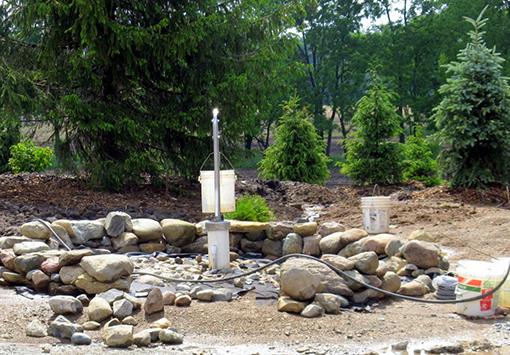Self-Assessment Questions (SAQs) for Study Session 3
Now that you have completed this study session, you can assess how well you have achieved its Learning Outcomes by answering these questions.
SAQ 3.1 (tests Learning Outcome 3.1)
Match the following words to their correct definitions.
Using the following two lists, match each numbered item with the correct letter.
permeable rocks
sand dam
water table
rainwater harvesting
protected water sources
percolated
drinking water ladder
run-off
unprotected water sources
precipitation
aquifers
a.something that describes the steps in improvement of quality of water supply
b.rocks that allow water to pass through them
c.the level of water below ground
d.layers of rock underground that hold water
e.passed through a porous material or through small holes
f.any form of water that falls on the Earth’s surface
g.rainwater that runs off land
h.water sources that have structures to prevent the entry of contaminants
i.the process of collecting and storing rainwater
j.a means of storing water using sand and a dam
k.water sources that do not have protective structures to stop them being contaminated
- 1 = b
- 2 = j
- 3 = c
- 4 = i
- 5 = h
- 6 = e
- 7 = a
- 8 = g
- 9 = k
- 10 = f
- 11 = d
SAQ 3.2 (tests Learning Outcome 3.2)
Place the following phrases alongside the appropriate water source:
quality can change with location and season; difficult to treat if contaminated; usually requires treatment; free of charge; can be easily polluted by industry and agriculture; likely to be free from pathogenic bacteria; can be polluted by bird droppings; can often have a high mineral content.
| Water source | Characteristics |
| groundwater | |
| surface water | |
| rainwater |
Answer
| Water source | Characteristics |
| groundwater |
|
| surface water |
|
| rainwater |
|
SAQ 3.3 (tests Learning Outcome 3.3)
Suppose that inhabitants of a village obtain water from a spring. What advice would you give to the users about the prevention of contaminants entering the spring?
Answer
The users of the spring should be advised to:
- avoid open defecation around the spring
- not construct latrines above the spring because of the danger of contaminating the groundwater
- use latrines properly
- keep animals away from the spring.
SAQ 3.4 (tests Learning Outcome 3.3)
Look at Figure 3.16, which shows a hand pump over a well. What would you recommend should be done to improve protection of this water source?

Answer
There should be a raised, smooth-sloping area around the pump for user safety and also so that any surface water or spillage runs off. The rock wall should be increased in height and a gate installed so that no animals can get near the pump and contaminate the area.
SAQ 3.5 (tests Learning Outcome 3.4)
Which of the following statements is false in relation to the development of a new water source? In each case explain why it is incorrect.
- A.The water source has to be reasonably close to the consumers of the water.
- B.Its environmental impact has to be ascertained.
- C.The effect of the seasons has to be considered.
- D.The quality of the raw water is immaterial, since modern treatment techniques can render it safe for drinking.
- E.The long-term viability of the source is important.
Answer
D is false. It is better to find a water source that is of good quality so that minimal treatment is required. This will keep costs low.
SAQ 3.6 (tests Learning Outcome 3.4)
List the factors that make a water source ideal to use.
Answer
The following are important factors for an ideal water source:
- capable of providing a supply that satisfies the anticipated demand and, in the case of groundwater, the rate of extraction not exceeding the rate of replenishment
- good water quality
- near to the consumers
- economical to use
- abstraction having minimal environmental impact.
Summary of Study Session 3
